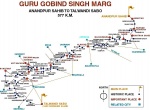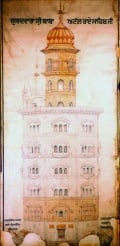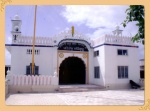Template:Did you know
From SikhiWiki
Jump to navigationJump to search
Did you know...
- .... that Baba Atal Rai was born in 1619 AD at Amritsar to Guru Hargobind Sahib, the sixth Sikh Guru and Mata Mahadevi, daughter of Bhai Daya Ram Marwah of Mandeala.....
- ....that Guru Gobind Singh had four adopted sons and the one of them was also called Zoravar Singh Palit - (palit means adopted). These four adopted sons were Baba Charan Singh, Baba Punjab Singh, Baba Ajaipal Singh and of course, Baba Zoravar Singh Palit.
- .... that the ninth Guru, Guru Tegh Bahadur on his way to Patna in east India visited Agra. A devout Sikh disciple lady invited Guru Tegh Bahadur to her house where he stayed for a day or two. Her name was Mai Jassi. The site of house has become a shrine and is known as Gurudwara Mai Than, Agra....
- .... that Sant Prem Singh (1882 - 1950) was an important social, political and religious leader who was a visionary and a social reformer and that he worked for Sikhism through Amrit Sanchaar and played important role for the uplift of the Lobana community.....
- .... that Gurudwara Bhagat Dhanna was constructed by Sant Baba Shisha Singh to facilitate devotees on their travels to and from the city the world knows as Nanded. Sikhs call the city Abichalnagar as the city is sacred to the memory of Guru Gobind Singh who left for his heavenly abode there....
- .... that Maharaja Duleep Singh (Lahore, 6 September 1838 - Paris, 22 October 1893) was a Sikh ruler of the sovereign state of Punjab, and the Sikh Empire. He was the last Maharaja of Lahore during the Sikh Raj of Punjab and was the youngest son of the legendary Lion of the Punjab (Maharaja Ranjit Singh) and the Messalina of the Punjab (Maharani Jind Kaur).....
- ... that Tarna Dal, the army of the youth, was one of the two main divisions of Dal Khalsa, the confederated army of the Sikhs during the eighteenth century, the other one being the Buddha Dal (army of the elders)....

click to enlarge
- .... that Guru Gobind Singh marg is the journey which started in December 1705 of the tenth Sikh master from Anandpur Sahib to Talwandi Sabo a distance of about 588 kilometres. Every place on this journey is sacred and has sanctity and is marked by the holy presence of this great personality....
- .... that Bhai Jivan Singh (1649-1705) was the name given to Bhai Jaita after he had received the rites of initiation at the hands of Guru Gobind Singh on the day - 30 March 1699 when the Khalsa was inaugurated....
- .... that it was at the place where the holy shrine, Takhat Sachkhand Sri Patna Sahib stands in Bihar India, that Guru Gobind Singh, the tenth Sikh Guru was born in 1666....
- .... that the history of the Ramgarhia bunga is inseparable from the history of the Golden Temple because its very existence is dependent on the latter. During the reign of the Mughal Emperors the temple was damaged or destroyed no less then seven times. But each time it was rebuilt by the Sikhs.


